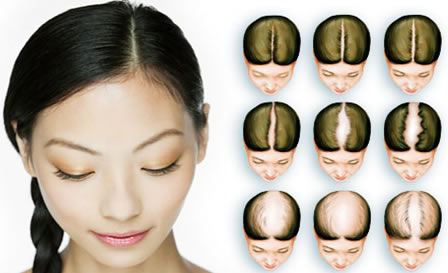What Can You Do for Female Hair Loss – More FAQs!
In women, hair can be an expression of style and even personality — also, self-image and hair are often closely intertwined. Therefore the health of your hair is very important. Unfortunately, female hair loss also can affect any women. Are there any natural ways to help deal with?
There are 3 major steps for your hair to keep regenerating – growing, resting, and shedding.
Cells of hair can grow and regenerate very rapidly. If they don’t get adequate nutrients that they need, you tend to have more hair loss than new hair growth. As a result, you may notice a thinning hair on the scalp.
The amounts of hairs on the scalp are about 100,000 on average. Each follicle has a single hair shaft. It can grow for about 0.5 inch /month. Then after the phase of growing for about 2-6 years, it will go into the phase of resting and eventually will fall out and replaced by the new one.
To support this cycle, hair follicles need plenty of essential nutrients for hair growth such as protein, vitamins, and minerals. In normal situation, about 15% of hairs on the scalp is resting and the rest is growing at any given time.
The pattern of female hair loss is slightly different if compared to men.
Women are more likely to have thinning hair that starts from the center part of the scalp. On the other hand, men tend to start their pattern hair loss from receding hairline. See the following picture (credit to Susan Gilbert and Peggy Firth)!

The causes of female hair loss may involve numerous different factors.
If you experience hair loss problem without known reason, see a dermatologist. You may be suggested to take tests to find out whether as a starting point – it’s much better to take a medical test to confirm whether it is related with issues of hormonal imbalances or certain medical condition.
Furthermore, some experts believe that a genetic trait and factors that comes in line with aging (such hormonal imbalance during pre-menopause and menopause) play a key role in causing thinning hair in women.
Other causes and factors that may lead to thinning hair in women:
- After giving a birth! During pregnancy, the phase of resting of follicles is paused temporarily. As a result, women tend to have more hair growth during pregnancy. But after giving birth, the pregnancy hormones gone and the phase of resting that was paused reoccur double, resulting more noticeable hair loss. See more in this section!
- Thyroid disease. Thyroid is a kind of gland (butterfly-shaped) that has crucial function to produce hormones for a lot of mechanisms in the body. If it works improperly, the life cycle of hairs may be affected too.
- Birth control pills. Some women report that they experience thinning hair during /after taking birth control pills.
- Autoimmune disorder. A kind of hair loss called alopecia areata is often triggered by the wrong response of the body immune system that attacks its own healthy follicles.
- Unhealthy extreme diet (crash diet). In crash diet, you are at high risk of losing a lot of essential nutrients from your diet. Women who lose their weight extremely may notice abnormal hair loss in the next 3-6 months.
- PCOS “Polycystic Ovary Syndrome”. This kind of disorder can cause excessive production of androgens (much higher than expected). It can lead to thinning hair on the scalp of head and hair loss on the other parts of the body.
- Sometimes ringworm may occur on the scalp of hair, causing hair loss or even a distinct pattern of thinning hair. In such case, antifungal medication is needed to cure the infection.
- Cancer and its treatments (chemotherapy and radiation therapy, for examples).
- Poor /improper hairstyles – such as tight hairstyles, combing wet hair, using hairdryer (particularly when you set hairdryer at too high temperature), using certain chemicals that affect the health of hair, etc.
There are several choices. And the effectiveness of the following treatment options is also closely dependent on the cause of the problem.
Also, the successful rate of treatment may vary from person to person.
If a genetic trait has a role, home remedies or natural hair-growth supplements alone are not enough.
But if the cause is a controllable factor such as lack of specific nutrient (poor diet) and stress, the hair problem would improve naturally once these controllable factors ware addressed, even without any medical intervention.
Practicing healthy habits as much as possible are also recommended. These can include; get enough sleep, stop smoking if you are a smoker, and avoid tight hairstyles!
Rogaine or medically also called Minoxidil is one of hair-growth medication that has been approved by the FDA. It can help slow the progress of hair loss.
But unfortunately, its effectiveness is not permanent. In other words, the problem of thinning hair may reoccur when you stop taking it.
Another option for female hair loss treatment is with a special device designed to emit laser (in low energy) in order to help stimulate and improve the chance of growing more hairs.
Does it work? Yes, it does. But its effectiveness is also closely related with the underlying cause of your hair loss.
In case of hair loss with inherited gene, the use of laser devices alone is probably not enough. What’s more?



